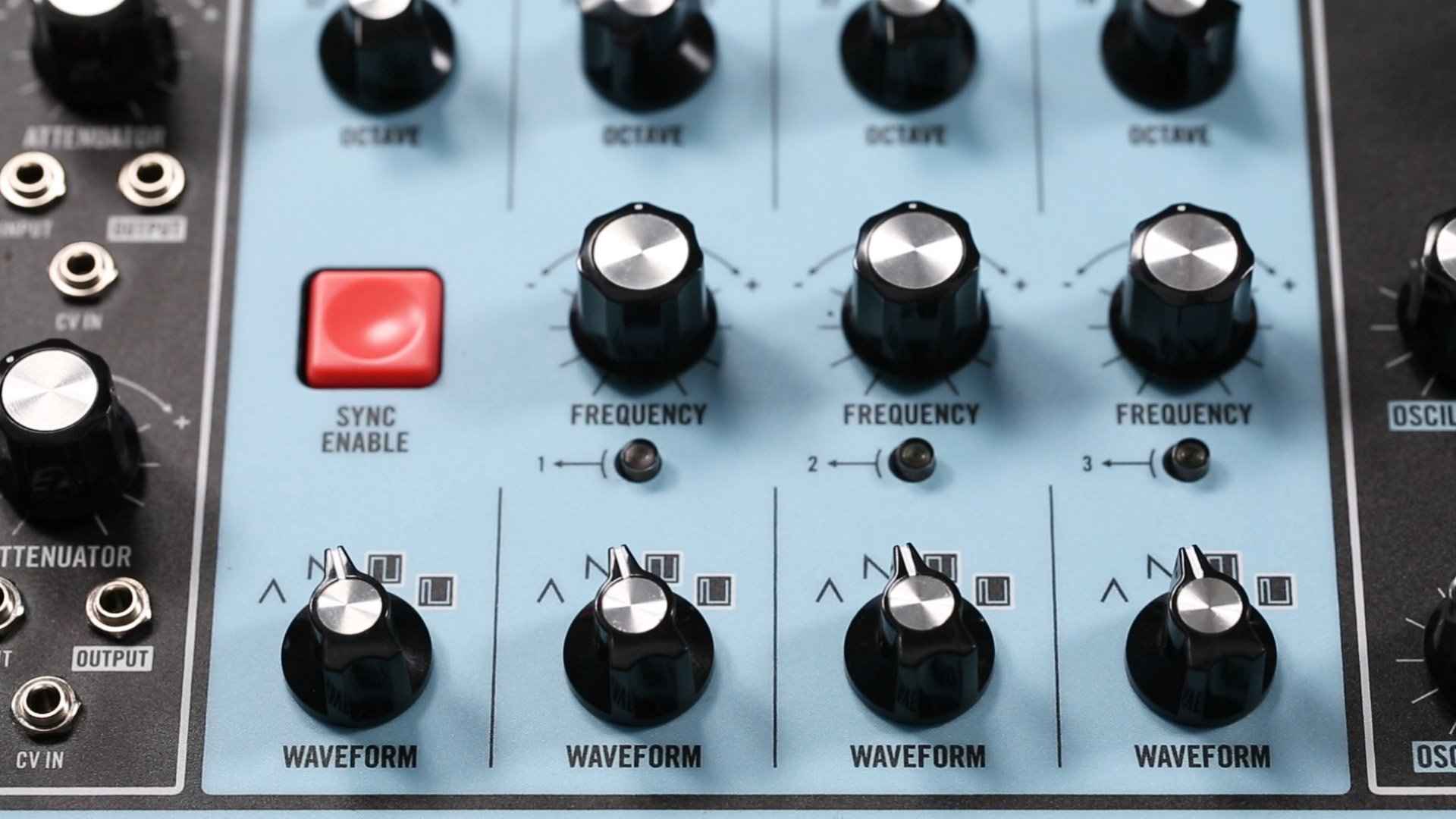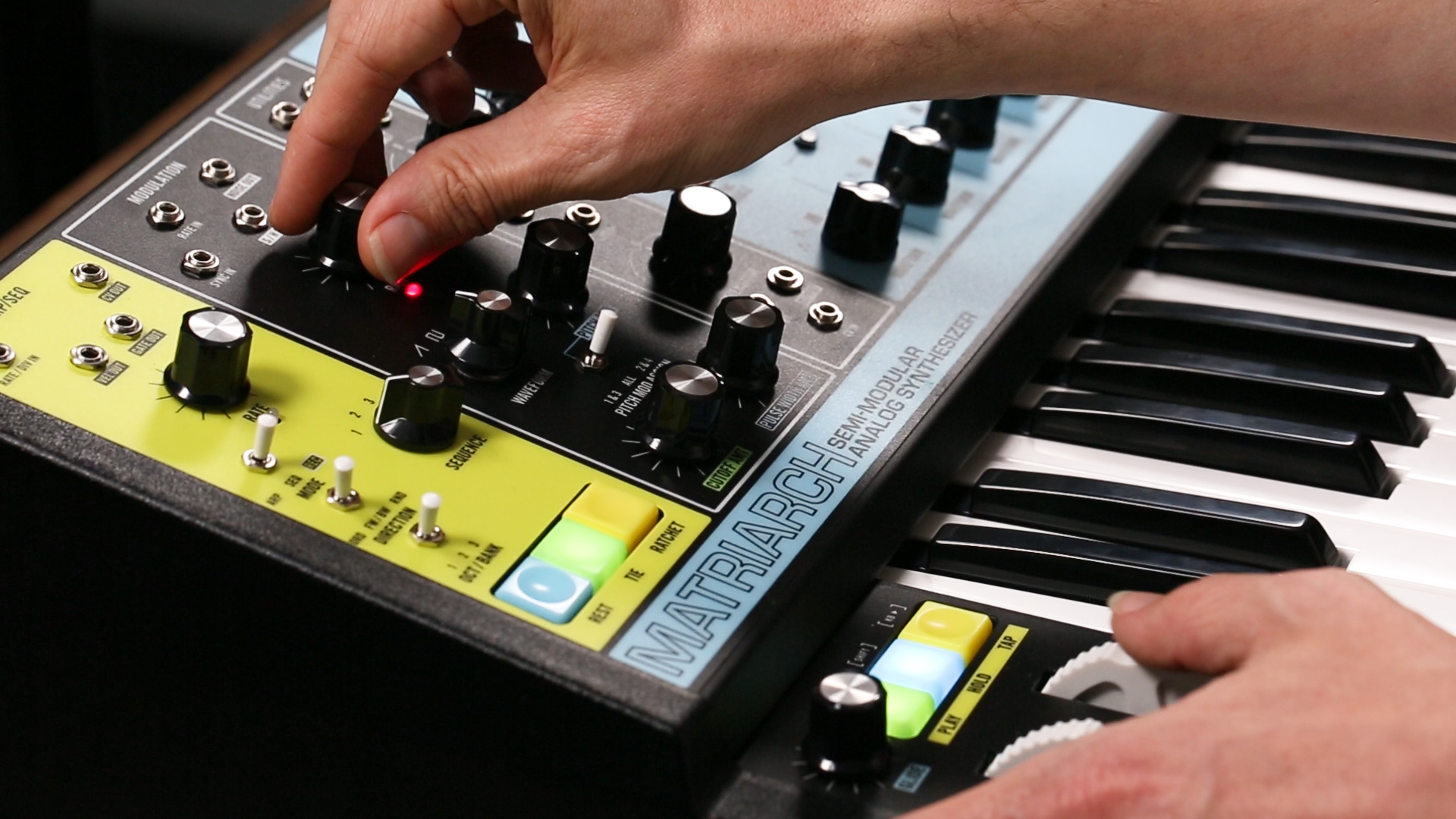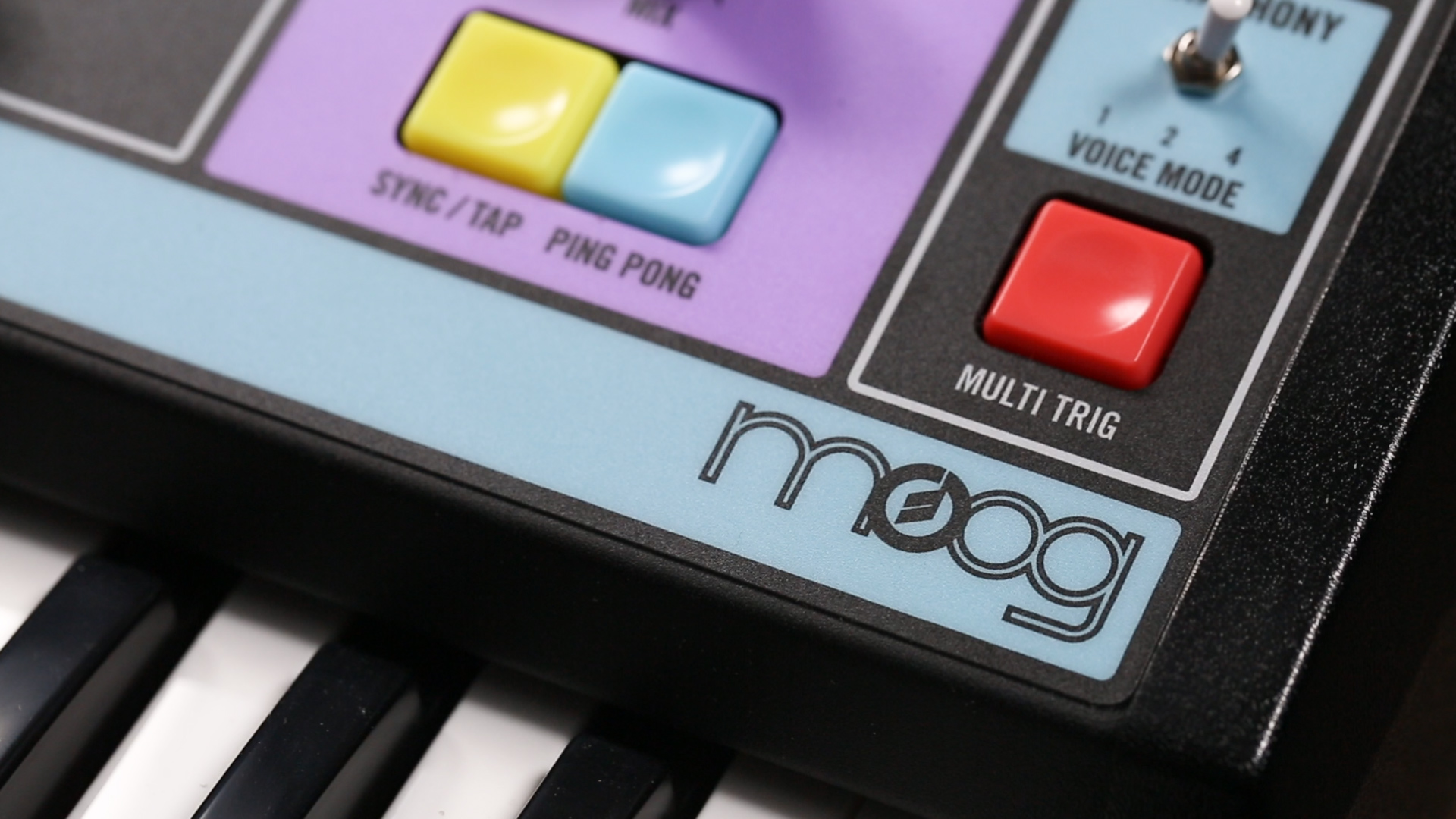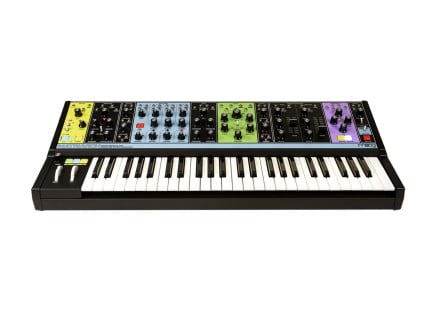First announced at Moogfest 2019, the Matriarch is the newest addition to Moog's growing synthesizer family. Following in the style of the Grandmother, Matriarch sports a loudly-colored front panel, all-analog signal path, and a semi-modular signal flow with tons of Eurorack patch points. But the Matriarch is much more than just an expanded Grandmother.
Matriarch's four oscillators provide the option for monophonic behavior, two-note paraphony, or four-note paraphony—meaning that Matriarch is fully capable of chords and complex layered sequences. After the mixer section, the default signal path is stereo: stereo analog filter, stereo VCA, and even a voltage-controllable, BBD-based stereo delay. Matriarch is rife with potential for wide stereo effects, from traditional panning to BBD reverbs, binaural filtering, and more.
And of course, the larger form factor and larger number of synthesis resources means expanded CV utilities and expanded patchability—making Matriarch not just an excellent keyboard synth, but an entire modular ecosystem all its own. A 100% open-ended signal architecture allows you to use Matriach's internal modules in any way, with any signal path: and of course, it can be directly interfaced with Eurorack synths and other semi-modular devices for limitless expansion.
We had the opportunity to spend some time with the Matriarch when making our demo video, so it seemed worthwhile to share some thoughts about what makes it different from the typical keyboard synth—and well, there is quite a lot to cover.
First Things First: Signal Flow
Matriarch's basic audio signal flow is essentially what one would expect—a standard subtractive signal path with plenty of welcome twists.

Without digging into the potential offered through patching, the default path starts first with four oscillators and an internal noise generator. These oscillators and noise have normalized connections into a mixer, providing independent level control for each of these five signal sources. This mixer offers a ton of gain on each channel, making it easily possible to distort each channel—but more on that later.
The signal then passes into the dual filter, then moving right along to a stereo VCA and stereo analog delay. The filter and VCA, as one might expect, each offer their own dedicated ADSR envelopes.
This configuration allows for immediate, gratifying performance as a keyboard synth: all typical parameters are easily accessible and everything has a front panel control, just as on the Grandmother. Even just this bird's eye view is promising—after all, it's a four-oscillator Moog synth with a stereo filter and stereo delay—but looking at Matriarch's individual sections piece by piece, its sheer power and utility quickly becomes apparent.
Paraphony is More than Fake Polyphony
So, the first obvious thing to focus on: the oscillators. Matriarch has four dedicated audio oscillators, each with independently selectable frequency range, wave shape, and fine tuning (for oscillators 2–4). When treated like a monophonic synth, this leads to absolutely immense unison sounds—simply dial in the level for each oscillator at the mixer and detune to taste. (Incidentally, I was a little bit concerned about having continuous tuning knobs for each oscillator—but the knobs are scaled perfectly, with plenty of "zero" space in the middle, so it is super easy to keep things completely in tune or to dial in stacked chords.)
 Detail of the Matriarch's four oscillators.
Detail of the Matriarch's four oscillators.
Each oscillator has a direct Pitch CV input, linear FM input, and Pulse Width Modulation input. And while there are dedicated internal routings from the internal LFO to the oscillators' pitch and PWM mod inputs, having direct patchable control of these parameters means that considerably more nuanced and independent modulations can occur: several oscillators whose pulse width changes independently, or whose pitches drift toward and away from one another.
The oscillators can also be synced to one another in a pretty large number of configurations, each useful for their own reasons. Oscillators 2–4 can each individually be synced to the preceding oscillator, with a master Sync Enable button acting as a killswitch for all enabled sync buttons. This in combination with the mixer allows for everything from classic Odyssey-style two-oscillator sync to simply outrageous chaotic sync behaviors (especially when combined with FM!) and more.
And then, one of the Matriarch's most obvious advantages: paraphony. A switch on the right-hand side of the panel allows selection of one of three voice modes: 1, 2, or 4. In "1" mode, all oscillators combine to form a super-huge voice...a four-oscillator monosynth with simply outrageous options for stacked chords, detuning, sync, etc. Switching to "2" mode organizes the oscillators into pseudo-duophonic behavior: oscillators one and two share note information, and oscillators three and four share note information. Switching into "4" mode, each new keypress is allocated a dedicated oscillator, enabling the creation of up to four-note chords.
 The Korg Mono/Poly, featuring a similar paraphonic architecture as the Matriarch.
The Korg Mono/Poly, featuring a similar paraphonic architecture as the Matriarch.
Note that this is not "true" polyphony. Because all oscillators share the same filter, VCA, and envelope section, notes cannot have fully independent levels or articulation. Using the Multi Trig button, you can choose whether the envelopes are rearticulated during held notes: with Multi Trig on, each new keypress rearticulates, but with it off, only the first of a group of held notes triggers the envelopes (much like the "legato" setting on many monosynths).
I personally believe that the Matriarch makes a strong case for why paraphony can be much more than just "fake polyphony." Seemingly inspired by Korg's classic Mono/Poly, the Matriarch makes available all kinds of weirdness. By using the same filters and VCAs but offering sufficient independence of the oscillators, some really interesting effects can be generated, in which the line between oscillators acting as individual entities or as a group becomes quite blurry.
Check out the video at the top of the page for some examples of what this behavior can mean, and what weird sonic options become available when you use a keyboard or sequencer to provide "round robin" control to several oscillators with different waveshapes and tuning ranges. One of my favorite patches in the video involves a trick where a bass note is constantly held in the left hand while the right hand plays a series of faster four-note patterns; by using three oscillators with different settings to play four-note sequences, bizarre patterns start to emerge, creating more complex rhythmic and melodic structures than the underlying keyboard technique would yield in other circumstances...kind of like an odd manually-operated arpeggiator/sequencer.
Binaural Filtering Strikes Again
The Matriarch has two classic Moog ladder filters, configured to provide a host of effects from bandpass filtering to intense stereo panning. Each filter has an independent resonance control, group key tracking control, and group envelope amount. An appropriately large master cutoff knob governs both filters, while a "spacing" knob provides an additional offset to the second filter. A selection of three modes determines the overall behavior: Series HP/LP, Stereo LP/LP, and Parallel HP/LP. And of course, it should go without saying that these filters carry all of the expected weight of a Moog filter: they sound staggeringly huge and shockingly smooth.
 The Matriarch's dual filter section, capable of multipeak filtering and binaural panning effects.
The Matriarch's dual filter section, capable of multipeak filtering and binaural panning effects.
In Series HP/LP, the two are run by default in mono and connected in series, providing a host of bandpass-like responses—and permitting variation and even modulation of bandwidth via the Spacing control and independent Cutoff CV inputs. In Parallel HP/LP, a mix of highpass and lowpass responses creates odd band-reject type effects, as well as formant-like reinforcements of particular frequencies (easily alterable via the filters' independent resonance controls).
Perhaps the most immediately mind-boggling mode, though, is the Stereo LP/LP mode, in which each filter is uses the same input signal but is routed to a separate VCA: one for the left output channel, one for the right output channel. By tuning the filters to separate frequencies, some truly bizarre effects can emerge. Clearly inspired by the Minimoog Voyager's filter section (and very much in the same spirit as the recently released Make Noise QPAS and SSF Stereo Dipole), this filter provides the potential for a huge array of binaural panning tricks, substituting conventional VCA-based panning techniques with methods that relate spatial position to timbre. Especially given that you can independently modulate each filter via the CV inputs, this makes possible some truly special panning effects for a startlingly wide stereo image (yet another trick that we couldn't help but try out in the demo video above).
Also worth noting: the filters do self-oscillate with ease, and produce a very clean sine-like waveform. When on the edge of self-oscillation, they can be "pinged" with reasonable success—that is, by sending low-frequency impulses into their audio inputs (from a square wave LFO, for instance), you can generate a pleasantly wet plop or pinging sound, great for odd percussive tones, stuttery croaks, and modulated gurgles.
 This delay is stereo, analog, voltage-controllable—and purple.
This delay is stereo, analog, voltage-controllable—and purple.
Stereo Delay Whussup?
The Grandmother's spring reverb is a key part of its sound, and we found that the Matriarch's delay feels equally embedded in its own sonic identity. While it would still sound rad without it, I couldn't help but constantly reach over to turn the mix up to add a little bit of warmth and lo-fi echo. For what it's worth, I also think it's awesome that Moog didn't simply copy over the reverb from the Grandmother; the delay helps to further the Matriarch's own overall sound, and is easily capable of murky reverb-like effects and beyond.
As you'd expect, Matriach offers direct controls for delay time, feedback, and mix. It can be synced to a clock with ease, and provides a ping-pong mode for deepening the potential for outrageous stereo effects. By turning the "spacing" control, one can offset the two delay's rates from one another—combined with the ping-pong mode, this makes for sounds that bounce back and forth in space.
Like the rest of the instrument, the delay has a wide host of available patch points, including CV inputs for feedback amount, wet/dry mix, and individual CV inputs for each delay's rate—great for classic swooshing, pitch-bending crunchy repeats and unruly modulations. Set at low enough time intervals, the delay can easily pull off the sound of a lo-fi reverb (all the better in ping-pong mode with each delay at slightly different rates), and when subtly modulated can produce lush vintage chorus effects difficult to achieve through other means.
It's awesome to see such a fully-featured analog delay built into a keyboard synth—let alone in stereo.
Endless Control
The Matriarch features the same style keyboard as the Grandmother, with the same style of sequencer and arpeggiator—though given its paraphonic nature, interacting with these systems can take on a very different nature than in its strictly monophonic predecessor. By using different timbre and pitch settings for each oscillator, sequences can take on completely new life—it wound up being a ton of fun simply setting up a cool sequence, latching it, and then messing with the oscillator settings as it played. In the paraphonic modes, this leads to the creation of peculiar, unexpected counterpoints...and if everything is set right, it can sound like an odd, jaunted multitrack sequencer. I've personally never played a synth quite like this—most paraphonic synths attempt to maintain the illusion of being fully polyphonic by making each "voice" conform to the same settings, but the Matriarch's independence between oscillators is a definite strong suit, leading it into territory I've never found with a self-contained analog instrument.
 Tinkering with the Matriarch's modulation section.
Tinkering with the Matriarch's modulation section.
Beyond the relatively standard keyboard, arpeggiator, sequencer, and pitch/mod wheels, the Matriarch offers even more options for control typically absent from keyboard synths—in essence, the Matriarch is a modular synth, albeit one with a normalized audio & control signal path. Where this differs from many semimodular synths is that basically all parameters have accessible patch points; very little is completely hidden below the surface, and the majority of useful patch points are available right on the front panel, inviting experimentation. This allows for complete deconstruction of the instrument's default architecture, turning each of its individual modules into raw elements that can be recombined to form completely new behaviors. Given the additional resources of the Matriarch (more oscillators, extra filter, extra LFO, etc.), this means potential for far more peculiar things than might immediately seem possible.
While the oscillators, filters, and delay are some of the more obvious talking points in the Matriarch, the other modules bear attention as well—in the spirit of modular synthesis, even seemingly simple, straightforward functions can take on unexpected roles. The Modulation section LFO, can easily take on a role as a fifth oscillator (as in the Grandmother), or, with the fluctuating random shape selected, can become a variable-brightness noise source. Even the envelopes can be used as cycling modulation sources or audio sources: simply patch the "end out" trigger into the envelope's trigger input and tune the attack and release times to taste—suddenly there are two extra oscillators, or two extra LFOs.

The Attenuators are also worth a closer look: whereas the Grandmother's attenuator section is a simple manual inverting attenuator (or attenuverter, or polarizer, or whatever you'd like to call it), the Matriarch's "attenuators" add a noteworthy extra feature: CV control of attenuation amount. This essentially turns this basic utility into something more—it acts as a DC-coupled VCA when fed unipolar modulation signals, or as a ring modulator when fed bipolar signals. And with three of these voltage-controllable attenuators onboard in addition to the two filters and two end-of-chain VCAs, it becomes possible to segment several of the Matriarch's internal oscillators into truly distinct voices—or to mangle things with multiple ring mods, or simply to allow dynamic scaling of control voltages. (Check out some thoughts about the many potential applications of VCAs and ring modulators in our Learning Synthesis: VCAs article.)
The Mixer deserves another moment of focus as well. Based on the legendary Moog CP-3, it shines as an audio mixer, providing a delightful-sounding distortion when driven hard (perfect for overdriving the filter). Interestingly, though, it is DC-coupled—meaning that it works equally well for mixing control voltages as it does audio. By patching signals into the mixer's inputs, the normalizations from the oscillators are defeated, making it possible to use the mixer to combine control signals for more complex and nuanced modulations. Of course, one could also use a low-frequency control signal to bias the oscillators running into the filter for peculiar distortions as well—it is 100% open-ended, and while a mixer may not seem at first like the most exciting part of a synth, I was super pleased to discover that it could be used for both CV and audio.
With all of these raw resources, it is easy to take the Matriarch out of keyboard territory and into much more peculiar places. Generative patches are easy to create—one could even use the keyboard to drive a simple paraphonic synth sound while a generative voice does its own thing independently. Matriarch is uncommonly flexible for a keyboard synth, to the point that the keyboard can feel simply like an extra control source attached to an otherwise very capable modular synth.
Who Needs Polyphony?
Of course, the Matriarch provides all the niceties one would expect: MIDI via DIN and USB, sustain pedal input, expression pedal input for additional CV control, and, as we've discussed, direct access to all parameters right on the front panel. Matriarch does not offer a preset system, but in practice this did not cause any problems; because every parameter is so immediately accessible, you can navigate fluidly from one sound to the next without any worry. There are separate controls for the headphone volume and main output volume as well, so it is easy to audition sounds when playing in a live context.

As I said earlier, many paraphonic synths attempt to maintain the illusion of being truly polyphonic...but Matriarch takes full advantage of all of the potential oddities that such an open-ended architecture provides. Following in the steps of the Korg Mono/Poly, each oscillator can have completely different settings—this combined with the basically full modularity of the signal path makes it such that Matriarch can get super weird super fast.
I am not much of a keyboardist, and as such, I do not usually get terribly excited about new keyboard synths...but this feels like a safe exception. Matriarch is going to be awesome in basically any musical context: it will make an excellent pad & lead synth for indie bands, will be perfectly welcome in any situation in need of a rumbling bass, will churn out sparkling delayed arpeggios for days, will go head-to-head with even the most unruly and noisy of generative Eurorack systems. Matriarch has no obvious pigeon hole, no directly-stated mission—instead, when using it, I couldn't help but feel that it could fit anywhere. For me, Matriarch truly does feel like one of the more special keyboard synths to come along in a good while, from Moog or otherwise...complete with its own idiosyncratic techniques that will no doubt manifest colorfully in all corners of electronic music. As with any instrument this open-ended, I cannot wait to hear what everyone does with it.








